Artistic labour in dance and painting: revisiting the theory-practice debate via mimesis (Anukrti) and the abject body
IF 0.3
0 ASIAN STUDIES
引用次数: 0
Abstract
ABSTRACT This article will critically explore how the intersection of mimesis and labour may open up another perspective on the much-theorized relationship between practice (prayoga) and theory (śāstra) in dance and painting. Labour or śrama, a loaded term by itself, will be taken in its complex sense of not only involving labour as skill that informs acts of painting, acting-dancing but also as a thematic of representation. Interspersed into these two senses is ritual labour or the labour involving acts of propitiating the divine – a domain not sufficiently thought out beyond the truism that religion pervades all spheres of Indic life. What this mode of inquiry aims to bring out is a tense relationship between manual/artistic labour and ritual labour both as a site of complicity and conflict amongst the actor-dancers and the authors of the treatises.舞蹈和绘画中的艺术劳动:通过模仿(阿努克蒂)和卑鄙的身体重新审视理论与实践的争论
摘要本文将批判性地探讨模仿和劳动的交叉如何为舞蹈和绘画中的实践(prayoga)和理论(śāstra)之间的理论关系开辟另一个视角。劳或śrama,一个本身就很重的术语,将被理解为其复杂的意义,即不仅将劳作为绘画、表演舞蹈的技能,还将其作为表现的主题。介于这两种意义之间的是仪式劳动或涉及安抚神的行为的劳动——这一领域没有经过充分的思考,超越了宗教渗透到印度人生活的各个领域这一真理。这种调查模式旨在揭示手工/艺术劳动和仪式劳动之间的紧张关系,这两者都是演员、舞者和论文作者之间共谋和冲突的场所。
本文章由计算机程序翻译,如有差异,请以英文原文为准。
求助全文
约1分钟内获得全文
求助全文

 求助内容:
求助内容: 应助结果提醒方式:
应助结果提醒方式:


